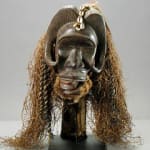Wobe Wooden Mask with Raffia Wig and Fur Beard, 20th Century CE
Wood and Mixed Media
8 x 11.5
PF.3503 (LSO)
Further images
This striking piece was made by the Wobe (also known as the We or the Gere-Wobe), who live in the western Ivory Coast. The face is essentially concave, with a...
This striking piece was made by the Wobe (also known as the We or the Gere-Wobe), who live in the western Ivory Coast. The face is essentially concave, with a bulging forehead – separated from the rest of the face by relief beading – and a very prognathic mouth with lolling tongue. The eyes are slits, the nose short and broad and the whole face framed by large inwardly-curved horns with upturned points, decorated with hatched lines. The mask has hair made of vegetable fibre, along with strands of cordage that are visible on the masks’ right side. The apex of the head is further decorated with a string of cowrie shells, while the lower jaw is clad in fur to give the impression of a beard. Patination is dark and even, and condition is good. This is a remarkable mask.
The Wobe are technically part of the We, along with the Gere, although for lexical and historical reasons – and for artistic purposes – they are associated as a stylistic group. They are governed by a complex system of confederations that are aligned with certain occupations; unsurprisingly, the warrior confederation is the strongest. Families are recognised units in We society, with the eldest member being their representative and organiser of everything from marriages to internalised social justice. Their masks have a great deal in common with the war masks made by their near neighbours, the Bete-Gere, especially in the proportions of the face (notably the mouth), the horns, and the addition of organic matter including raffia and cordage. Others are reminiscent of the more minimalistic style of the Dan, which is especially visible in We statuary and also in some social characteristics (reverence for the forest, masquerades etc). It is perhaps significant that this mask is both evidently an older male, and a symbol of power, for almost all these tribes relied upon gerontocracies as sources of social cohesion.
This is a powerful and impressive piece of African art.
The Wobe are technically part of the We, along with the Gere, although for lexical and historical reasons – and for artistic purposes – they are associated as a stylistic group. They are governed by a complex system of confederations that are aligned with certain occupations; unsurprisingly, the warrior confederation is the strongest. Families are recognised units in We society, with the eldest member being their representative and organiser of everything from marriages to internalised social justice. Their masks have a great deal in common with the war masks made by their near neighbours, the Bete-Gere, especially in the proportions of the face (notably the mouth), the horns, and the addition of organic matter including raffia and cordage. Others are reminiscent of the more minimalistic style of the Dan, which is especially visible in We statuary and also in some social characteristics (reverence for the forest, masquerades etc). It is perhaps significant that this mask is both evidently an older male, and a symbol of power, for almost all these tribes relied upon gerontocracies as sources of social cohesion.
This is a powerful and impressive piece of African art.







